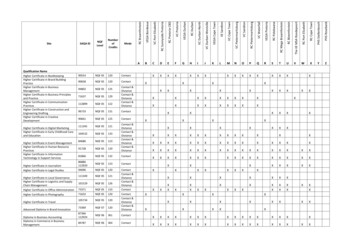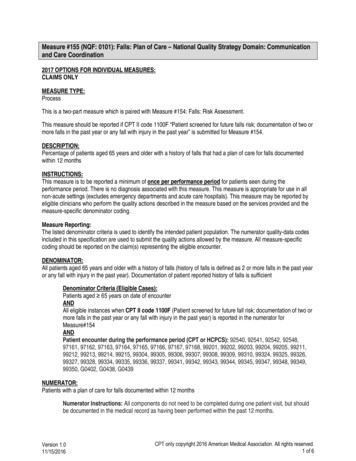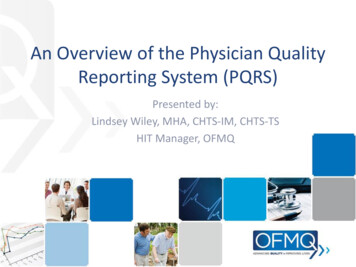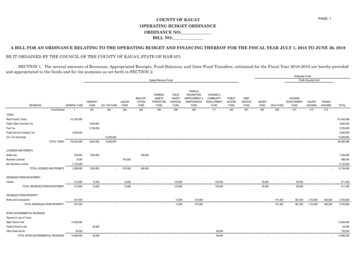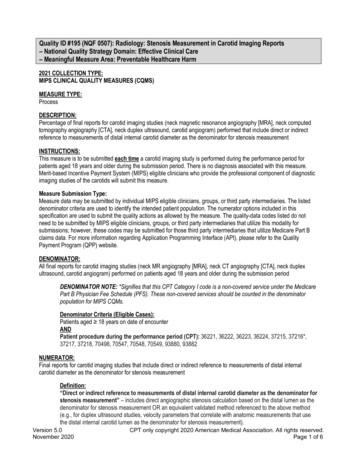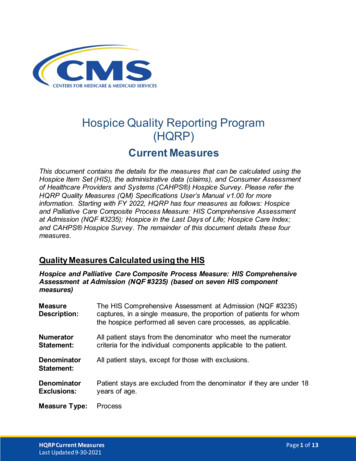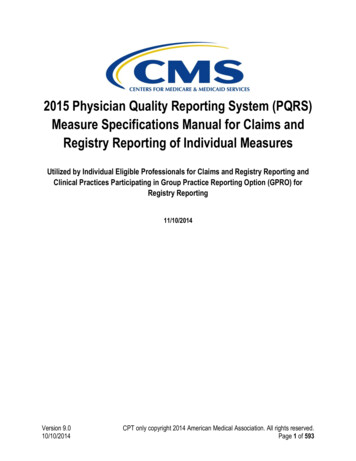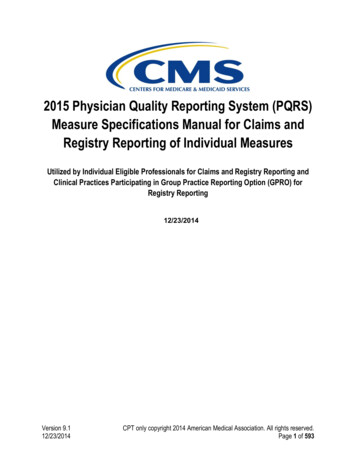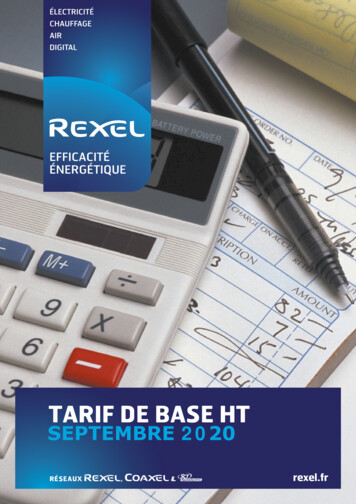
Transcription
Quality ID #154 (NQF: 0101): Falls: Risk Assessment– National Quality Strategy Domain: Patient Safety– Meaningful Measure Area: Preventable Healthcare Harm2020 COLLECTION TYPE:MEDICARE PART B CLAIMSMEASURE TYPE:Process – High PriorityThis is a two-part measure which is paired with Measure #155: Falls: Plan of Care. If the falls risk assessmentindicates the patient has documentation of two or more falls in the past year or any fall with injury in the past year(CPT II code 1100F is submitted), #155 may also be submitted.DESCRIPTION:Percentage of patients aged 65 years and older with a history of falls that had a risk assessment for falls completedwithin 12 monthsINSTRUCTIONS:This measure is to be submitted a minimum of once per performance period for patients seen during theperformance period. There is no diagnosis associated with this measure. This measure is appropriate for use in allnon-acute settings (with the exception of emergency departments and acute care hospitals). This measure may besubmitted by Merit-based Incentive Payment System (MIPS) eligible clinicians who perform the quality actionsdescribed in the measure based on the services provided and the measure-specific denominator coding.Measure Submission Type:Measure data may be submitted by individual MIPS eligible clinicians using Medicare Part B claims. The listeddenominator criteria are used to identify the intended patient population. The numerator quality-data codes includedin this specification are used to submit the quality actions allowed by the measure on the claim form(s). All measurespecific coding should be submitted on the claim(s) representing the denominator eligible encounter and selectednumerator option.DENOMINATOR:All patients aged 65 years and older who have a history of falls (history of falls is defined as 2 or more falls in the pastyear or any fall with injury in the past year). Documentation of patient reported history of falls is sufficientDenominator Criteria (Eligible Cases):Patients aged 65 years on date of encounterANDPatient encounter during the performance period (CPT or HCPCS): 92540, 92541, 92542, 92548,97161, 97162, 97163, 97164, 97165, 97166, 97167, 97168, 99201, 99202, 99203, 99204, 99205, 99211,99212, 99213, 99214, 99215, 99304, 99305, 99306, 99307, 99308, 99309, 99310, 99324, 99325, 99326,99327, 99328, 99334, 99335, 99336, 99337, 99341, 99342, 99343, 99344, 99345, 99347, 99348, 99349,99350, G0402, G0438, G0439NUMERATOR:Patients who had a risk assessment for falls completed within 12 monthsDefinitions:Fall – A sudden, unintentional change in position causing an individual to land at a lower level, on an object,the floor, or the ground, other than as a consequence of sudden onset of paralysis, epileptic seizure, oroverwhelming external force.Version 4.0November 2019CPT only copyright 2019 American Medical Association. All rights reserved.Page 1 of 9
Risk Assessment – Comprised of balance/gait AND one or more of the following: postural blood pressure,vision, home fall hazards, and documentation on whether medications are a contributing factor or not to fallswithin the past 12 months.Balance/gait Assessment - Medical record must include documentation of observed transfer and walkingor use of a standardized scale (e.g., Get Up & Go, Berg, Tinetti) or documentation of referral for assessmentof balance/gait.Postural blood pressure - Documentation of blood pressure values in supine and then standing positions.Vision Assessment - Medical record must include documentation that patient is functioning well with visionor not functioning well with vision based on discussion with the patient or use of a standardized scale orassessment tool (e.g., Snellen) or documentation of referral for assessment of vision.Home fall hazards Assessment - Medical record must include documentation of counseling on home fallshazards or documentation of inquiry of home fall hazards or referral for evaluation of home fall hazards.Medications Assessment - Medical record must include documentation of whether the patient’s currentmedications may or may not contribute to falls.Numerator Instructions:All components do not need to be completed during one patient visit, but should be documented in themedical record as having been performed within the past 12 months.NUMERATOR NOTE: The correct combination of numerator code(s) must be submitted on the claim formin order to properly submit this measure. The “correct combination” of codes may require the submission ofmultiple numerator codes.ORORNumerator Quality-Data Coding Options:Patient receiving Hospice Services, Patient Not Eligible:(One code [G9718] is required on the claim form to submit this numerator option)Denominator Exclusion: G9718:Hospice services for patient provided any time duringthe measurement periodORIf patient is not eligible for this measure because patient has documentation of no falls or only onefall without injury the past year, submit: Patient not at Risk for Falls(One CPT II code [1101F] is required on the claim form to submit this numerator option)Denominator Exclusion: CPT II 1101F:Patient screened for future fall risk; documentation ofno falls in the past year or only one fall without injuryin the past yearORIf patient is not eligible for this measure because falls status is not documented, submit:Falls Status not Documented(One CPT II code [1101F-8P] is required on the claim form to submit this numerator option)Append a submission modifier (8P) to CPT Category II code 1101F to submit circumstances when thepatient is not eligible for the measure.Denominator Exclusion: 1101F with 8P:No documentation of falls statusRisk Assessment for Falls Completed(Two CPT II codes [3288F &1100F] are required on the claim form to submit this numerator option)Performance Met: CPT II 3288F:Falls risk assessment documentedANDCPT II 1100F:Patient screened for future fall risk; documentation oftwo or more falls in the past year or any fall with injuryin the past yearVersion 4.0November 2019CPT only copyright 2019 American Medical Association. All rights reserved.Page 2 of 9
Risk Assessment for Falls not Completed for Medical Reasons(Two CPT II codes [3288F-1P & 1100F] are required on the claim form to submit this numerator option)Denominator Exception: 3288F with 1P:Documentation of medical reason(s) for notcompleting a risk assessment for falls (i.e., patient isnot ambulatory, bed ridden, immobile, confined tochair, wheelchair bound, dependent on helperpushing wheelchair, independent in wheelchair orminimal help in wheelchairANDCPT II 1100F:Patient screened for future fall risk; documentation oftwo or more falls in the past year or any fall with injuryin the past yearORRisk Assessment for Falls not Completed, Reason not Otherwise Specified(Two CPT II codes [3288F-8P & 1100F] are required on the claim form to submit this numerator option)Append a submission modifier (8P) to CPT Category II code 3288F to submit circumstances when theaction described in the numerator is not performed and the reason is not otherwise specified.Performance Not Met: 3288F with 8P:Falls risk assessment not completed, reason nototherwise specifiedANDCPT II 1100F:Patient screened for future fall risk; documentation oftwo or more falls in the past year or any fall with injuryin the past yearRATIONALE:Screening for specific medical conditions may direct the therapy. Although the clinical guidelines and supportingevidence calls for an evaluation of many factors, it was felt that for the purposes of measuring performance andfacilitating implementation this initial measure must be limited in scope. For this reason, the work group defined anevaluation of balance and gait as a core component that must be completed on all patients with a history of falls aswell as four additional evaluations – at least one of which must be completed within the 12 month period. Dataelements required for the measure can be captured and the measure is actionable by the physician.CLINICAL RECOMMENDATION STATEMENTS:Older people who present for medical attention because of a fall, or report recurrent falls in the past year, ordemonstrate abnormalities of gait and/or balance should be offered a multifactorial falls risk assessment. Thisassessment should be performed by a health care professional with appropriate skills and experience, normally in thesetting of a specialist falls service. This assessment should be part of an individualized, multifactorial intervention.(NICE) (Grade C)Multifactorial assessment may include the following: Identification of falls historyAssessment of gait, balance and mobility, and muscle weaknessAssessment of osteoporosis riskAssessment of the older person’s perceived functional ability and fear relating to fallingAssessment of visual impairmentAssessment of cognitive impairment and neurological examinationAssessment of urinary incontinenceAssessment of home hazardsCardiovascular examination and medication review (nice) (grade c)Version 4.0November 2019CPT only copyright 2019 American Medical Association. All rights reserved.Page 3 of 9
A falls risk assessment should be performed for older persons who present for medical attention because of a fall,report recurrent falls in the past year, report difficulties in walking or balance or fear of falling, or demonstrateunsteadiness or difficulty performing a gait and balance test.The falls risk evaluation should be performed by a clinician with appropriate skills and experience.[C] A falls risk assessment is a clinical evaluation that should include the following, but are not limited to: A history of fall circumstancesReview of all medications and dosesEvaluation of gait and balance, mobility levels and lower extremity joint functionExamination of visionExamination of neurological function, muscle strength, proprioception, reflexes, and tests of cortical,extrapyramidal, and cerebellar functionCognitive evaluationScreening for depressionAssessment of postural blood pressureAssessment of heart rate and rhythmAssessment of heart rate and rhythm, and blood pressure responses to carotid sinus stimulation ifappropriateAssessment of home environmentThe falls risks assessment should be followed by direct intervention on the identified risk. [A] (AGS)COPYRIGHT:Physician Performance Measures (Measures) and related data specifications have been developed by the PCPI Foundation (PCPI ) and the National Committee for Quality Assurance (NCQA). These Measures are not a clinicalguideline and does not establish a standard of medical care, and has not been tested for all potential applications.The Measures, while copyrighted, can be reproduced and distributed, without modification, for noncommercialpurposes, eg, use by health care providers in connection with their practices. Commercial use is defined as the sale,license, or distribution of the Measures for commercial gain, or incorporation of the Measures into a product orservice that is sold, licensed or distributed for commercial gain. Commercial uses of the Measures require a licenseagreement between the user and the PCPI or NCQA. Neither the American Medical Association (AMA), nor theformer AMA-convened Physician Consortium for Performance Improvement(R), PCPI, NCQA nor its members shallbe responsible for any use of the Measure. 2019 NCQA and PCPI Foundation. All Rights Reserved.THE MEASURES AND SPECIFICATIONS ARE PROVIDED "AS IS" WITHOUT WARRANTY OF ANY KIND.Limited proprietary coding is contained in the Measure specifications for user convenience. Users of proprietary codesets should obtain all necessary licenses from the owners of the code sets. NCQA disclaims all liability for use oraccuracy of any CPT or other codes contained in the specifications.CPT contained in the Measure specifications is copyright 2004-2019 American Medical Association. LOINC copyright 2004-2019 Regenstrief Institute, Inc. This material contains SNOMED Clinical Terms (SNOMED CT )copyright 2004-2019 International Health Terminology Standards Development Organisation. ICD-10 is copyright2019 World Health Organization. All Rights Reserved.Version 4.0November 2019CPT only copyright 2019 American Medical Association. All rights reserved.Page 4 of 9
Version 4.0November 2019CPT only copyright 2019 American Medical Association. All rights reserved.Page 5 of 9
Version 4.0November 2019CPT only copyright 2019 American Medical Association. All rights reserved.Page 6 of 9
2020 Medicare Part B Claims Flow Narrative for Quality ID#154 NQF #0101:Falls: Risk AssessmentDisclaimer: Refer to the measure specification for specific coding and instructions to submit this measure.Start with DenominatorCheck Patient Age:a. If Patient Age is greater than or equal to 65 Years on Date of Encounter equals No during themeasurement period, do not include in Eligible Population. Stop Processing.b. If Patient Age is greater than or equal to 65 Years on Date of Encounter equals Yes duringthe measurement period, proceed to check Encounter Performed.Check Encounter Performed:a. If Encounter as Listed in the Denominator equals No, do not include in Eligible Population. StopProcessing.b. If Encounter as Listed in the Denominator equals Yes, include in Eligible Population.Denominator Population:a. Denominator Population is all Eligible Patients in the Denominator. Denominator is represented asDenominator in the Sample Calculation listed at the end of this document. Letter d equals 80 patients inthe Sample Calculation.Start NumeratorCheck Hospice Services For Patient Provided Any Time During the Measurement Period:a. If Hospice Services For Patient Provided Any Time During the Measurement Period equals Yes, includein Data Completeness Met and Denominator Exclusion.b. Data Completeness Met and Denominator Exclusion is represented as Data Completeness andPerformance Rate in the Sample Calculation listed at the end of this document. Letter x1 equals 0patients in Sample Calculation.c. If Hospice Services For Patient Provided Any Time During the Measurement Period equals No, proceedto check Patient Screened for Future Fall Risk, Documentation of No Falls or Only One Fall withoutInjury in Past Year.Check Patient Screened for Future Fall Risk, Documentation of No Falls or Only One Fall without Injury inPast Year:a. If Patient Screened for Future Fall Risk, Documentation of No Falls or Only One Fall without Injury inPast Year equals Yes, include in Data Completeness Met and Denominator Exclusion.b. Data Completeness Met and Denominator Exclusion is represented as Data Completeness andPerformance Rate in the Sample Calculation listed at the end of this document. Letter x2 equals 0patients in Sample Calculation.c. If Patient Screened for Future Fall Risk, Documentation of No Falls or Only One Fall without Injury inPast Year equals No, proceed to check No Documentation of Falls Status.Version 4.0November 2019CPT only copyright 2019 American Medical Association. All rights reserved.Page 7 of 9
Check No Documentation of Falls Status:a. If No Documentation of Falls Status equals Yes, include in Data Completeness Met and DenominatorExclusion.b. Data Completeness Met and Denominator Exclusion is represented in the Data Completeness andPerformance Rate in the Sample Calculation listed at the end of this document. Letter x3 equals 10patients in the Sample Calculation.c. If No Documentation of Falls Status equals No, proceed to check Risk Assessment for FallsDocumented AND Patient Screened for Future Fall Risk, Documentation of 2 or More Falls or Any Fallwith Injury in Past Year.Check Risk Assessment for Falls Documented AND Patient Screened for Future Fall Risk, Documentation of2 or More Falls or Any Fall with Injury in Past Year:a. If Risk Assessment for Falls Documented AND Patient Screened for Future Fall Risk, Documentation of2 or More Falls or Any Fall with Injury in Past Year equals Yes, include in Data Completeness Met andPerformance Met.b. Data Completeness Met and Performance Met is represented as Data Completeness and PerformanceRate in the Sample Calculation listed at the end of this document. Letter a equals 30 patients in theSample Calculation.c. If Risk Assessment for Falls Documented AND Patient Screened for Future Fall Risk, Documentation of2 or More Falls or Any Fall with Injury in Past Year equals No, proceed to check Risk Assessment forFalls Not Completed for Documented Medical Reasons and Documentation of 2 or More Falls or AnyFall with Injury in Past Year.Check Risk Assessment for Falls Not Completed for Medical Reasons and Documentation of 2 or More Fallsor Any Fall with Injury in Past Year:a. If Risk Assessment for Falls Not Completed for Medical Reasons and Documentation of 2 or More Fallsor Any Fall with Injury in Past Year equals Yes, include in Data Completeness Met and DenominatorException.b. Data Completeness Met and Denominator Exception is represented as Data Completeness andPerformance Rate in the Sample Calculation listed at the end of this document. Letter b equals 10patients in Sample Calculation.c. If Risk Assessment for Falls Not Completed for Medical Reasons and Documentation of 2 or More Fallsor Any Fall with Injury in Past Year equals No, proceed to check Risk Assessment for Falls NotCompleted, Reason Not Otherwise Specified and Documentation of 2 or More Falls or Any Fall withInjury in Past Year.Check Risk Assessment for Falls Not Completed, Reason Not Otherwise Specified and Documentation of 2or More Falls or Any Fall with Injury in Past Year:a. If Risk Assessment for Falls Not Completed, Reason Not Otherwise Specified and Documentation of 2 orMore Falls or Any Fall with Injury in Past Year equals Yes, include in the Data Completeness Met andPerformance Not Met.b. Data Completeness Met and Performance Not Met is represented as Data Completeness in the SampleCalculation listed at the end of this document. Letter c equals 20 patients in the Sample Calculation.Version 4.0November 2019CPT only copyright 2019 American Medical Association. All rights reserved.Page 8 of 9
c. If Risk Assessment for Falls Not Completed, Reason Not Otherwise Specified and Documentation of 2 orMore Falls or Any Fall with Injury in Past Year equals No, proceed to check Data Completeness Not Met.Check Data Completeness Not Met:a. If Data Completeness Not Met, the Quality Data Code was not submitted. 10 patients have beensubtracted from the Data Completeness Numerator in the Sample Calculation.Version 4.0November 2019CPT only copyright 2019 American Medical Association. All rights reserved.Page 9 of 9
submitted by Merit-based Incentive Payment System (MIPS) eligible clinicians who perform the quality actions described in the measure based on the services provided and the measure-specific denominator coding. Measure Submission Type: Measure data may be submitted by individual MIPS eligible clinicians using Medicare Part B claims. The listed
